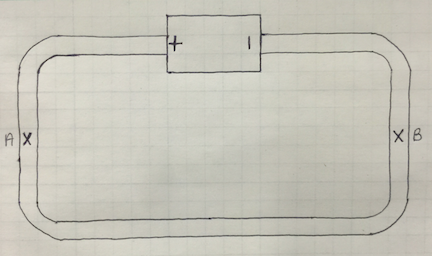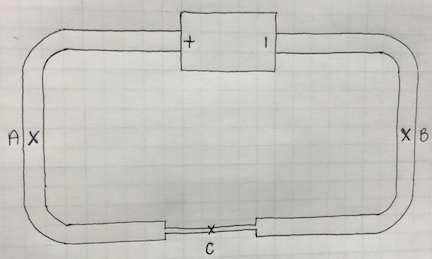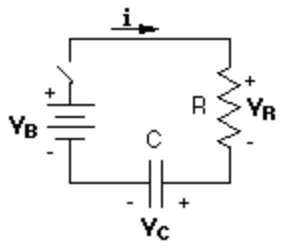Steady State: Difference between revisions
| Line 50: | Line 50: | ||
===Middling=== | ===Middling=== | ||
[[File: | [[File:SSCircuitsB.png]] | ||
===Difficult=== | ===Difficult=== | ||
Revision as of 22:21, 5 December 2015
claimed by Shirin Kale
Steady state is the term used to describe an assembled circuit in which the current and net electric field are constant and stay approximately constant for a very long time. Circuits with uniform thickness and composition can be described as steady state if charged particles move with constant current in each section of a wire in the circuit. Circuits in the steady state do not change current as a function of time.
The Main Idea
After a circuit has been assembled, it can be described as steady state if it meets the following requirements:
- mobile charges are moving with constant drift velocity anywhere in the circuit
- no excess charges accumulate anywhere in the circuit
Although mobile charges are moving, the drift velocities of the charges do not vary with time at any location in the circuit and thus, the current is constant throughout the circuit. However, since current is also a function of the cross-sectional area and charge density (composition) of the wire - as shown by the equation for conventional current below - a steady state circuit is more specifically described as one in which the current is constant in each section of a wire with uniform thickness and composition.
A Mathematical Model
i = electron current
I = conventional current
v = drift speed
q = charge of mobile particles
A = cross-sectional area of wire
In the steady state, at each section of circuit:
A Conceptual Understanding
Because mobile charges are moving (with constant drift speed) in the circuit, there must be an applied electric field inside the wire that causes the mobile charges to move. Since there is no excess charge inside the wire, the electric field must be produced from surface charges. And because this electric field is responsible for moving the mobile charges inside the wire, the direction of the electric field at each location in the wire must be parallel to the wire.
Once a circuit is described as being in the steady state, there are three things we know to be true. It is true that:
- there must be a nonzero electric field in the wire
- the electric field has uniform magnitude throughout the wire
- the electric field is parallel to the wire at every location along the wire
The electric field and current inside the wire remains constant because the electric force (F = qE) acting on the mobile charged particles and allowing them to move through the circuit is canceled out by the drag force produced by the moving charged particles such that the net force is zero and thus, acceleration is zero.
When you assume that a circuit is in steady state, you are basically assuming that the circuit has been assembled and connected for a long time (such that the current is constant). However, there is a process that occurs - when the circuit is first assembled - before the circuit reaches steady state. Let’s take a look at some examples to better understand steady state circuits.
Examples
Simple
Middling
Difficult
Connectedness
- How is this topic connected to something that you are interested in?
- How is it connected to your major?
- Is there an interesting industrial application?
History
Put this idea in historical context. Give the reader the Who, What, When, Where, and Why.
See also
Are there related topics or categories in this wiki resource for the curious reader to explore? How does this topic fit into that context?
Further reading
Books, Articles or other print media on this topic
External links
Internet resources on this topic
References
This section contains the the references you used while writing this page


